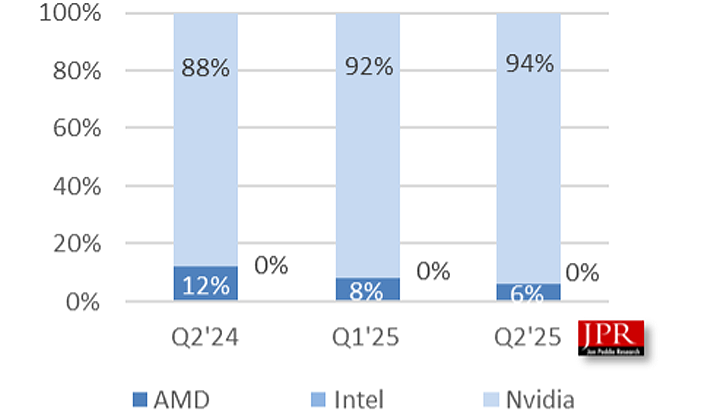Overall shipments of GPUs increased by 8.4% to 74.7 million units in the second quarter, which is a sign of pre-tariff panic buying, according to a pair of reports by Jon Peddie Research. That figure includes 66.9 million PC processor shipments with integrated GPUs, and if accounting for those, Intel is the top dog with a 61% share of the market. However, discrete shipments favor NVIDIA and in a much bigger way.
If narrowing the focus to discrete GPUs, including both desktop and mobile solutions, NVIDIA increased its dominating market share to 94%, up from 92% in the previous quarter and 88% in the same quarter a year ago.
 Source: Jon Peddie Research
Source: Jon Peddie Research
AMD accounts for the remaining 6%, and even though Intel is technically a participant in the discrete GPU space with its Arc Alchemist and
Battlemage GPUs, it didn't ship enough chips to register a blip, with its market share noted at 0%. However, JPR says there are
persistent rumors of Intel launching more discrete graphics cards, including a dual-GPU model.
Looking at the GPU landscape, it's really a tale of two distinct markets, including integrated and discrete GPUs. As far as discrete GPUs go, JPR noted an unusual trend.
"AIB prices dropped for midrange and entry-level, while high-end AIB prices increased, and most retail suppliers ran out of stock. This is very unusual for the second quarter," said Dr. Jon Peddie, president of Jon Peddie Research. "We think it is a continuation of higher prices expected due to the tariffs and buyers trying to get ahead of that."
In other words, it appears as though supply and pricing are normalizing, at least to some extent, as we've commented on in the recent past. To wit, earlier today we highlighted a pair of graphics cards that, for the the first time we're aware of, are on
sale for below NVIDIA's baseline MSRPs. They include factory-overclocked GeForce RTX 5070 Ti (PNY) and GeForce RTX 5070 (ASUS) models.
It could also be indicative of a rumored GeForce RTX 50 Super refresh. Early leaks and rumors suggest that the upcoming Super models will
occupy the same price points as the launch MSRPs for the non-Super versions. That's to say, the GeForce RTX 5070 Ti Super will debut at $749, which is the same launch price as the non-Super version.
Shifting to the GPU market as a whole (not just discrete GPUs), total year-to-year shipments on all platforms increased by 4.9%.
"The upheaval and uncertainty over tariffs have not abated, making planning difficult or impossible for PC suppliers. Supply chains are being reconfigured every week, trying to offset the impact of the threats and a few cases of actual tariffs," Peddie said. "Consumers are equally confused and worried, which will likely result in a pullback, further exacerbating the market. We don’t see how the market can do anything but decline in such uncertain times."
Peddie made the above comment in the
overall GPU shipment report. He also mentions tariffs in the
discrete shipment report, though it's not clear if the same level of 'confusion' and 'worry' apply, or if the upswing in shipments is more in line with rabid demand for the newest GPU architectures.

